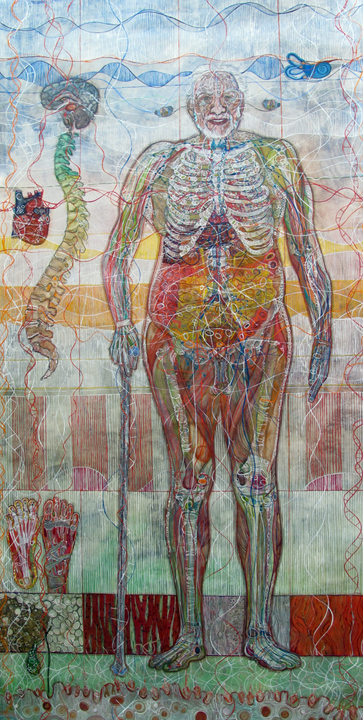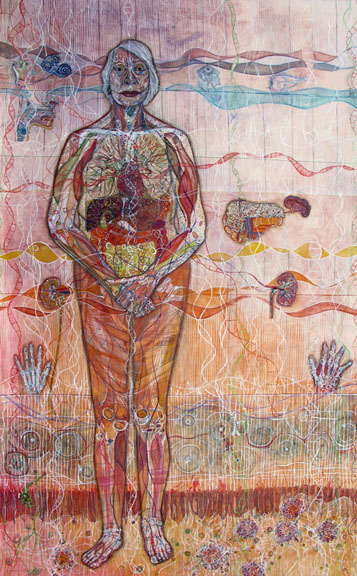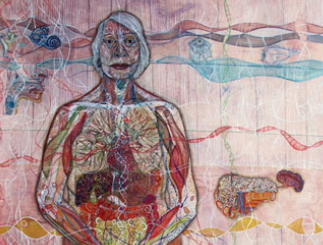This interview is re-created from the conversation I had with Monica Martinez, the artist responsible for the Nothing in Stasis exhibit that is currently in the lobby of the HSEB. An interview from earlier in her career can be found here: https://www.youtube.com/watch?v=0Q9fx8STKMI
How did you become interested in making art?
I’ve been making things since I was in grade school probably. Teachers noted my ability, and kept my interest going.
I attended college at the University of Texas in El Paso and began a more serious study of art, specifically metalsmithing and ceramics. I moved to New Mexico State University to get my graduate degree in fine art, particularly drawing and printmaking.
What made you decide to change media?
I went to NMSU to study with a printmaking professor whose work I admired. He reconnected me to my love of drawing. I didn’t think about the changing of mediums. It’s all about the continuous study of art making.
What made you interested in medical artwork?
It surprises me that you use the term medical artwork. I like that you call it medical; it makes sense where you are coming from. I don’t really call it medical artwork. It is the study of humans, and of being human. My current focus in on the body. In the past I looked at other aspects, like psychology and emotions. Eventually and naturally, I went on to look at the human physical body.
Being athletic from an early age and my eventual study of Yoga, including a Yoga Teacher Training Course, it feels natural to move in this direction. Yoga instructors place you in the body. The move you through the organs. This in particular is what got me wanting to draw anatomy. My work has become more realistic in some ways, but that is because the more I learn, the more I want to put it down on paper.
What themes do you try to convey with your artwork?
I don’t think in terms of themes. My work is based on what interests me. I follow my curiosity. I want to educate myself on particular things; right now it’s anatomy and physiology.
Perhaps everything related to being a human is what interests me. I don’t think about it as a theme. I think about it as life. My progression is organic.
I educate myself and perhaps I can educate the viewer.
The Nothing in Stasis Project:
What inspires you with that work?
I see those works as narratives. Each one of those pieces tells a story. All of those people in my compositions really exist. Each drawing is a mapping of sorts: a mapping of their body, a part of their life story.
How do you decide on your subjects?
Take the images of my parents, for example. I know them well. And I have a natural connection and concern for them. Consider I want to educate myself about my parents – their history and their life – through the body. Ideas come to me in various ways…the people I am connecting with, books I am reading….even a word…might peek my curiosity.
“Portrait of Sophie, Trisomy 21 Study” is one example where I read a book called My Heart Can’t Even Believe It, A Story of Science, Love and Down Syndrome. All the elements caught my attention and I wanted to put some of them down on paper. People share personal things with me. They send medical X-rays along with their personal medical stories (history). I get excited about somethings, or feel the issue is worthwhile, and believe I can take it somewhere, perhaps educate and/or create dialogue. I have a nice collection of anatomy books and research material, some I have purchased and some medical friends have given me. All of that stuff has gotten my imagination going.
Do you have any particular stories you want to share with your artwork?
We can talk about two works if you like: the portraits of my father (Patrilineal Study), and my mother (Matrilineal Study). They each took me about a year to research and draw. My father is a retired psychologist. His brain, in that image, is connected to his life’s work. Now, my father is in the early stages of dementia. The detail in that work takes an unexpected turn. I realize now with everything I set up in that drawing, he might have actually been exhibiting signs of dementia even then, and we did not realize it. The drawing has taken on a new dimension. And about the study of my mother, who is pre-diabetic: note I include elements of that imbalance. Her previous doctor also diagnosed her with mild RA. I include details concerning this, like her hands and the slightly twisting fingers. Very recently, her current (different from previous) doctor told her he does not see RA. The story has changed. The narrative, the course of events, is marked down in the drawing, but now it changes. These two studies concerning two people I know and care about have changed the way I see things. Maybe my study has changed the way I see and understand things.

Portrait of Roberto, A Patrilineal Study

Portrait of Elisa, A Matrilineal Study
Mohammad Khan is a fourth-year medical student in The University of Arizona College of Medicine – Phoenix, Class of 2021. He graduated from Arizona State University in 2014 with two bachelor's degrees in biochemistry and biology. He then worked as a teacher and completed a Master's in biomedical diagnostics in 2017. For fun, Mohammad (who also goes by Mokha) likes to practice at the archery range, work on calligraphy, game, and fountain pen writing, and read science fiction novels. He is interested in medicine with a focus on educating patients.

